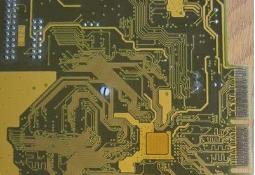The formation of slots in PCB design process includes:
Grooves caused by power supply or ground plane segmentation; When there are many different power supplies or ground on the PCB board, it is generally impossible to allocate a complete plane for each power supply network and ground network. The common practice is to divide the power supply or ground on one or more planes. Grooves are formed between different segments on the same plane.
Through holes are too dense to form grooves (through holes include pads and holes); When the through-hole passes through the formation or power supply layer without electrical connection, some space should be left around the through-hole for electrical isolation; But when the through-holes get too close together, the isolation rings overlap, creating grooves.

Influence of double slotting on EMC performance of PCB version
Slotting has a certain influence on THE EMC performance of PCB board, which may be negative or positive. First we need to understand the surface current distribution of high speed signal and low speed signal. At low speeds, the current flows along the path of the resistance. As shown in the figure below, when the low-speed current flows from A to B, its backflow signal returns to the source from the ground plane. At this point, the surface current distribution is wide.
At high speeds, the inductance in the signal backflow path will outweigh the resistance. The high-speed backflow signal will flow along the path of the impedance. At this time, the surface current distribution is very narrow, the backflow signal is concentrated in bundles below the signal line.
When incompatible circuits exist on the PCB, ground plane should be set according to different power supply voltage, digital and analog signals, high speed and low speed signals, high current and low current signals. It can be easily understood from the distribution of high speed and low speed backflow signals given above that the separation can prevent the stac
king of backflow signals of incompatible circuits and prevent the coupling of the impedance of the common ground.
However, no matter high speed signal or low speed signal, when the signal line crosses the power plane or the slot on the ground plane, it will bring many serious problems, including:
Increase the current loop area, increase the loop inductance, so that the output waveform is easy to oscillate;
For high-speed signal lines that need strict impedance control and are routed according to the ribbon-line model, the ribbon-line model will be destroyed by slotting in the upper or lower plane or the upper and lower plane, resulting in discontinuity of impedance and serious signal integrity problems.
Increase radiation emission into space, and at the same time susceptible to interference of space magnetic field;
The high frequency voltage drop on the loop inductor constitutes the common mode radiation source, and the common mode radiation is generated through the external cable.
Increase the possibility of high-frequency signal crosstalk with other circuits on the board (figure below).
PCB design for slotting treatment
The treatment of slotting should follow the following principles:
For high-speed signal lines requiring strict impedance control, the track is strictly forbidden to cross the split line to avoid impedance discontinuity and serious signal integrity problems;
When incompatible circuits exist on the PCB board, ground separation should be carried out, but the ground separation should not cause the high-speed signal line across the split line, nor should it cause the low-speed signal line across the split line.
Bridge cables when routing across grooves is unavoidable.
Connectors should not be placed on formation intersections. If there is A large potential difference between point A and point B on the formation in the figure, common mode radiation may be generated through the external cable.
In PCB design of high-density connectors, unless there are special requirements, the ground network should generally be ensured around each pin, and the ground network can also be evenly arranged during pin layout to ensure the continuity of the ground plane and prevent the generation of grooves.